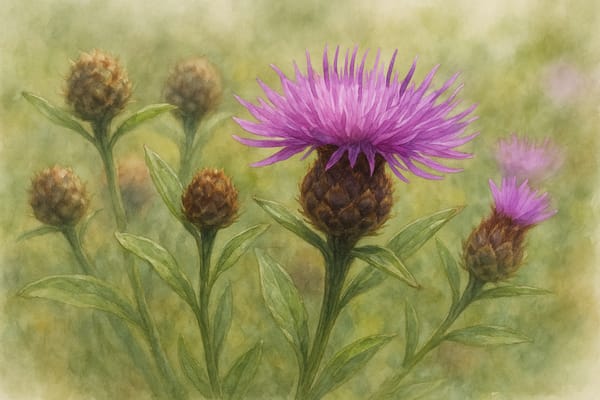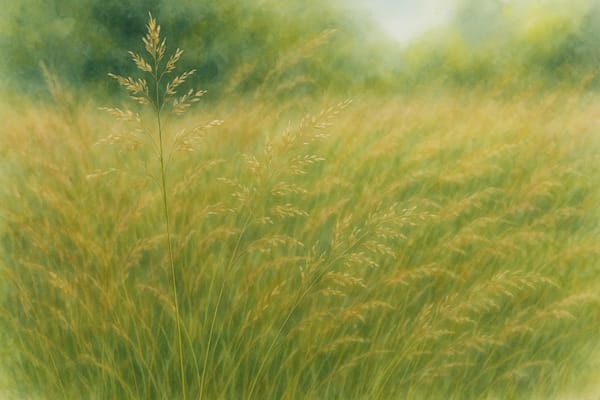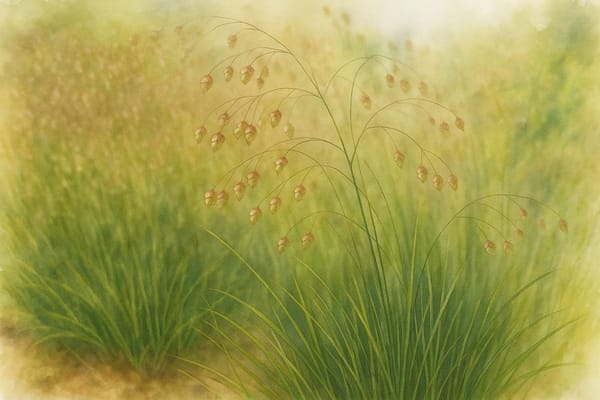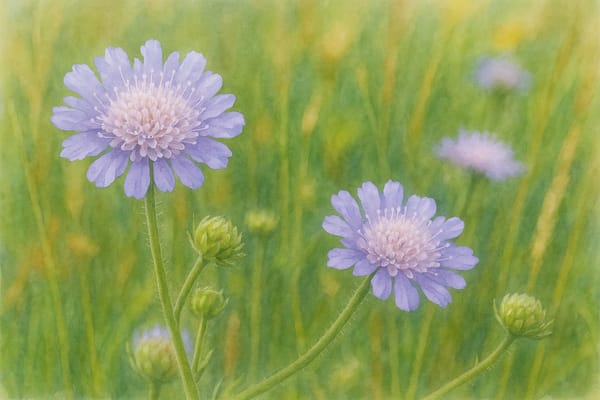There is a kind of quiet authority to knapweed—its tufted, purple crowns rising on wiry stems above the grass like emblems of persistence. In Cornish meadows, roadside verges, and wilder garden corners, Centaurea nigra, or common knapweed, weaves itself into the texture of late summer, its blooms humming with bees and holding firm even as other flowers begin to fade. But this plant is more than a pollinator’s pantry—it is a complex, sometimes contradictory player in the ecology of our grasslands, and one that rewards closer attention.
A Keystone in Bloom: The Biodiversity Value of Knapweed
Few wildflowers rival knapweed’s value to insects. Its generous, nectar-rich blooms are a magnet for pollinators—visited daily by bumblebees, honeybees, solitary bees, hoverflies, moths, butterflies, and beetles. In national wildflower surveys, Centaurea nigra regularly ranks among the top five UK plants for nectar provision, and it continues flowering from June into October, making it a critical resource during late summer when forage becomes scarce.
After flowering, knapweed offers yet more—its seed heads feed finches and other seed-loving birds, providing sustenance long after the colour has faded. In this way, knapweed plays a quiet but central role in maintaining seasonal continuity in food supplies for insects and birds alike.
Its benefits go deeper still. With a taproot that plunges deep into the soil, it breaks up compacted ground, helps prevent erosion, and supports better water infiltration, especially on sloped or sandy ground—qualities that are especially valuable in Cornwall’s more exposed or coastal sites.
Rooted Resilience: Growing and Gardening with Knapweed
For gardeners seeking to enrich biodiversity with little fuss, knapweed is an ideal choice. It is hardy, drought-tolerant, and well adapted to Cornwall’s soil palette, including poorer, drier, and slightly alkaline conditions. It thrives in full sun or light shade, self-seeds modestly, and requires little more than the occasional cutback or deadheading if you wish to prolong flowering.
It fits beautifully into:
- Wildflower meadows and field margins
- Naturalistic cottage gardens
- Wildlife-friendly road verges or orchard fringes
- Urban planting schemes aiming for wild charm
But this easygoing nature has a sharper edge. When not thoughtfully managed, knapweed’s success can spill over into competition with more delicate species—and its relationship with the soil microbiome is more complex than its surface appearance suggests.
The Hidden Chemistry: Allelopathy and Microbial Disruption
Beneath the soil, knapweed engages in subtle warfare. Like many successful wild plants, Centaurea nigra produces allelochemicals—natural compounds that are released through its roots and decaying matter. These substances, including phenolic acids and other secondary metabolites, can suppress the growth of competing plant seedlings and alter microbial communities in the rhizosphere.
One of the most concerning effects is the inhibition of arbuscular mycorrhizal fungi (AMF). These fungi are crucial partners for most native plants, helping them extract water and nutrients (especially phosphorus) from the soil. Knapweed’s chemical arsenal disrupts this beneficial relationship, weakening the native plants it competes with while bolstering its own dominance. This process can result in a “soil legacy effect”—a lasting shift in soil microbiota that lingers even after knapweed has been removed.
This microbial shift may also influence beneficial bacteria, favouring species that support knapweed’s growth while suppressing others that native plants rely on during early development. Over time, the soil becomes subtly but significantly less hospitable to wildflower diversity, with knock-on effects for the insects and birds that depend on it.
When Abundance Becomes Imbalance: The Invasive Potential of Knapweed
Though knapweed is native to the UK, including Cornwall, it can act invasively—especially in disturbed, overgrazed, or unmanaged grasslands. In these situations, it forms dense stands or monocultures, excluding more delicate plants through both physical crowding and allelopathic suppression.
This decline in plant diversity reduces:
- Floral choice for pollinators
- Structural variety for insects and birds
- Nutrient cycling supported by a balanced microbial and faunal community
In some contexts, knapweed can reduce nitrogen levels and organic carbon in the soil, impacting not only what grows but how ecosystems function. And once established, these changes can persist for years, making habitat restoration far more difficult and costly.
Balance Over Ban: Managing Knapweed Responsibly
Given its ecological contributions and potential risks, knapweed presents a classic case for thoughtful, balanced management. In a garden or managed meadow, it is rarely a problem when grown as part of a diverse mix of native species. But in larger landscapes or restoration sites, monitoring and occasional intervention may be needed to ensure it doesn't outcompete less vigorous flora.
Some simple approaches:
- Deadhead spent blooms to limit self-seeding where space is tight
- Mow or scythe meadows annually, removing cuttings to reduce nutrient build-up and promote diversity
- Combine knapweed with complementary species like yarrow, oxeye daisy, birdsfoot trefoil, and red clover to create balance and staggered flowering
In this way, Centaurea nigra becomes an anchor species, not a monoculture tyrant, offering food, structure, and soil enrichment without tipping the ecological scales.
A Flower for Now—and the Future
In the climate-aware garden, few plants are as climate-resilient, pollinator-rich, and soil-friendly as common knapweed. It offers beauty without pretension, structure without rigidity, and function that ripples outward through entire ecosystems.
In Cornwall, where rugged coastlines meet damp hollows and sunlit banks, knapweed finds its place easily. Whether you’re restoring a meadow, enriching a smallholding, or simply scattering a handful of seeds into a forgotten corner, this flower meets the moment: hardy, generous, imperfect—and vital.











